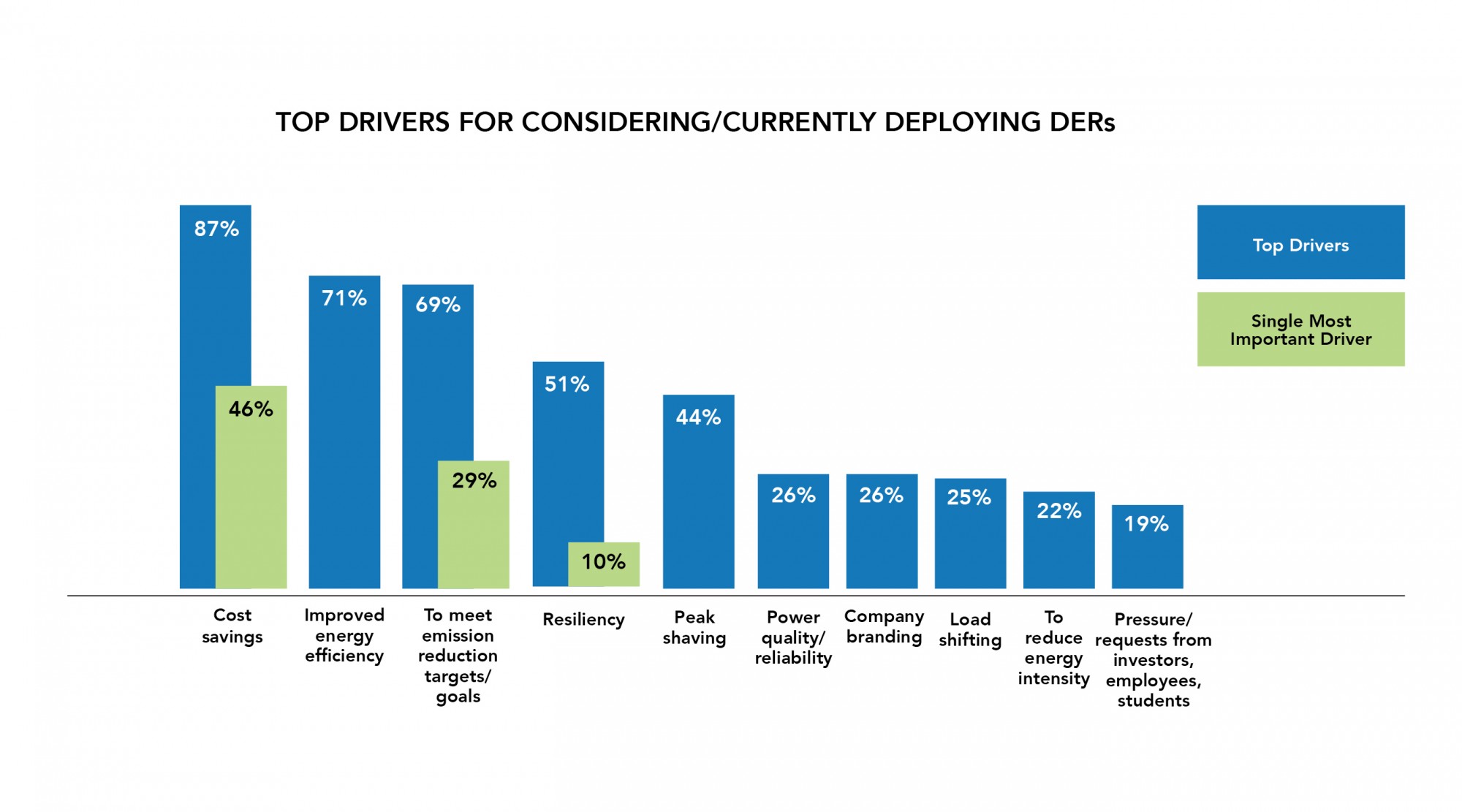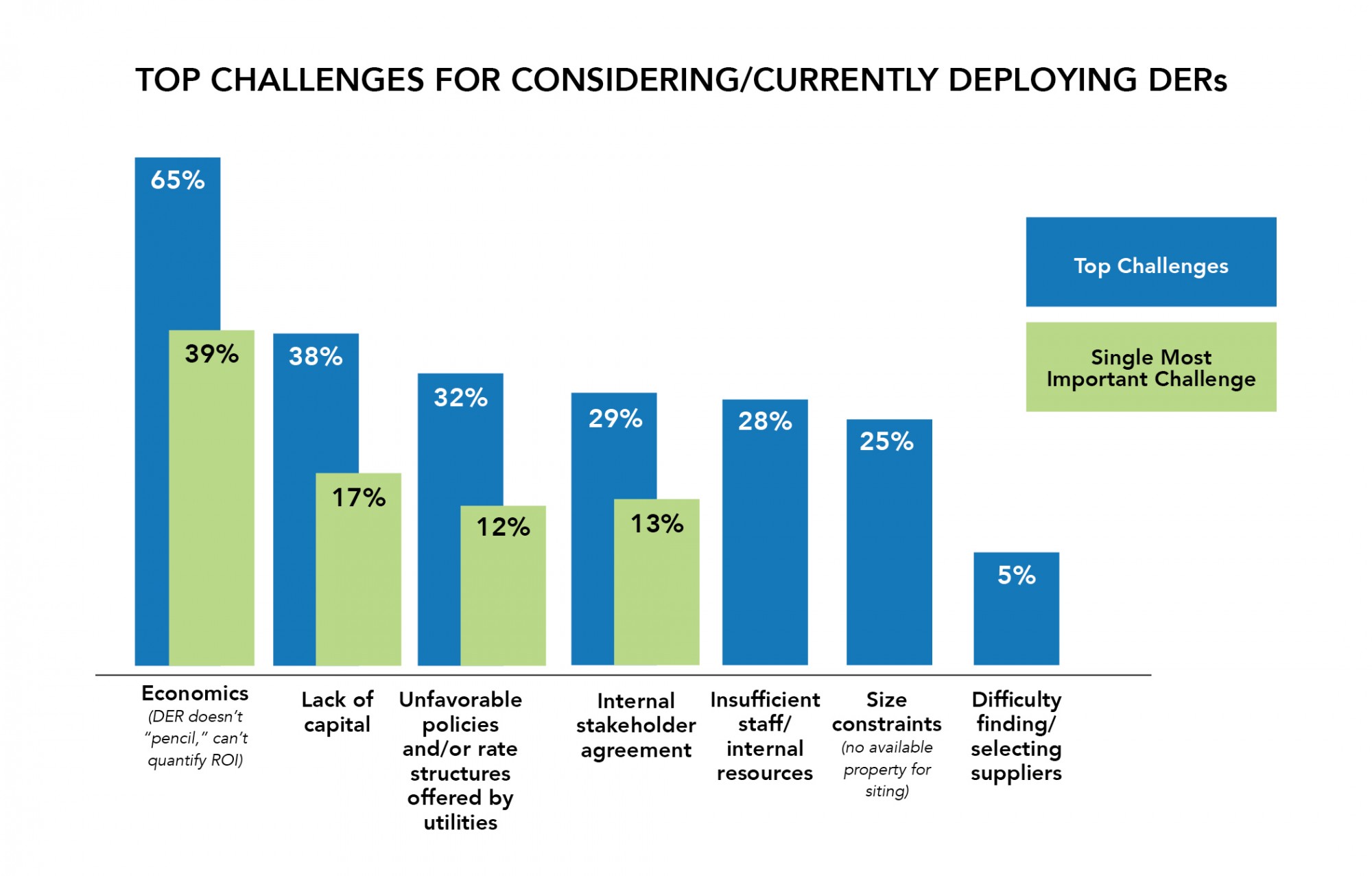Distributed Energy Resources - February 24, 2021 - By NRG Energy, Inc.
Energy Cost & Control: DER Survey Insights, Part 1
As the U.S. energy landscape continues to undergo a transformational shift, how and where power is generated has emerged as a key driver in the transition. The evolution of electric energy systems is moving toward a more decentralized power grid that now includes local power generation that is being put directly in the hands of energy customers through the use of Distributed Energy Resources (DERs). These include a broad array of options: onsite solar, electric vehicle charging infrastructure, demand response, CHP/cogeneration, energy storage, natural gas generators, fuel cells, microgrids, and biomass systems.
The 2020 “State of Distributed Energy Resources Study,” conducted by Smart Energy Decisions and sponsored by NRG Energy, Inc. (NRG) shows that cost savings are driving DER adoption by customers. A majority of respondents (87%) cited this factor as a top reason for deploying DERs, while nearly half (46%) called it the single top driver. Beyond that, these customers – commercial, industrial, institutional, and government organizations - are seeking solutions that provide improved efficiency (71%), a way to meet sustainability targets (69%), and resiliency (51%).
The demand on customers to lower operating expenses has pushed the industry to implement alternative energy management practices. Limitations are being exposed in the currently fragmented power structure, where supply and DERs operate in independent silos. In order to reap the benefits of data-driven DERs, customers should understand that planning, design, operations, and maintenance work more efficiently when connected with a holistic view of the entire enterprise.
Another factor driving adoption is that electricity costs from renewable energy have fallen steadily in recent years, especially for solar systems. Today, power from renewable technologies has become increasingly competitive with, and sometimes even less costly than, fossil fuel-based power. When these cost savings are combined with so many flexible DER options that can provide energy conservation, modify consumption, and manage load and crucial times, DERs become more visible and viable.

Economics tops the list of barriers
Despite its growth, DERs face several barriers to wider adoption. Study results show 65% of respondents are troubled by the economics of DERs; they struggle to make these systems “pencil” or cannot quantify their ROI. Further, 38% stated a lack of capital as a top challenge. Another deterrent to adoption is stakeholder buy-in; even though interest in deployment is high, the lack of internal agreement and competing objectives has slowed the acceptance process. This points to a lack of understanding and the need for more education about the benefits of DERs, a situation that may be evolving as more corporate energy departments become part of sustainability decision-making along with finance, facilities, and legal.
Barriers persist as utility rate structures remain unfavorable, although this situation may be beginning to shift as there have been some limited changes in regulations. Still, many states continue to lack regulatory clarity for DER integration, and complicated or nonexistent interconnect policies are widespread.
The good news is that customers can get control of the challenges by working with a seasoned integrated power company that is data-driven and experienced in turning goals into sustainable solutions. Each DER implementation comes with its own set of challenges, making it more important than ever to partner with an energy provider with expansive experience in all aspects of energy sourcing and management.

Take Control. Solve Problems
Customer-focused energy providers with deep and varied capacity to transform goals into solutions can offer a well-orchestrated approach where one vendor delivers a holistic custom, DER strategy. For example, NRG worked with a commercial company to tailor a demand response program that reduced energy consumption by 7.4 megawatts saving nearly $275,000 in the first three months. Another project featured a healthcare operator with a goal to reduce environmental impact and operating costs. Working with NRG, they established a combined heat and power plant (CHP) that resulted in an 18.1M lbs. carbon offset, eliminated the need for purchasing several energy sources, and resulted in an annual savings of $1.2M and zero debt over five years.
Customers have the power to control their on-site DER and related expenses to maximize ROI. Bundling products and services together where one supplier brings a total solution also results in better pricing. Businesses often do not realize that many avenues exist to leverage these assets and drive down costs. Smart energy choices are available in many forms. Partnerships that offer products and services together and as-a-service options, more easily gain the full benefit from DERs often with little capital expenditure.
Read more in the 2020 State of Distributed Energy Resources Study.
 At NRG, we’re bringing the power of energy to people and organizations by putting customers at the center of everything we do. We generate electricity and provide energy solutions and natural gas to more than 3.7 million residential, small business, and commercial and industrial customers through our diverse portfolio of retail brands. A Fortune 500 company, operating in the United States and Canada, we deliver innovative solutions while advocating for competitive energy markets and customer choice, and working towards a sustainable energy future.
At NRG, we’re bringing the power of energy to people and organizations by putting customers at the center of everything we do. We generate electricity and provide energy solutions and natural gas to more than 3.7 million residential, small business, and commercial and industrial customers through our diverse portfolio of retail brands. A Fortune 500 company, operating in the United States and Canada, we deliver innovative solutions while advocating for competitive energy markets and customer choice, and working towards a sustainable energy future.
Read These Related Articles:
Stay Up-To-Date












